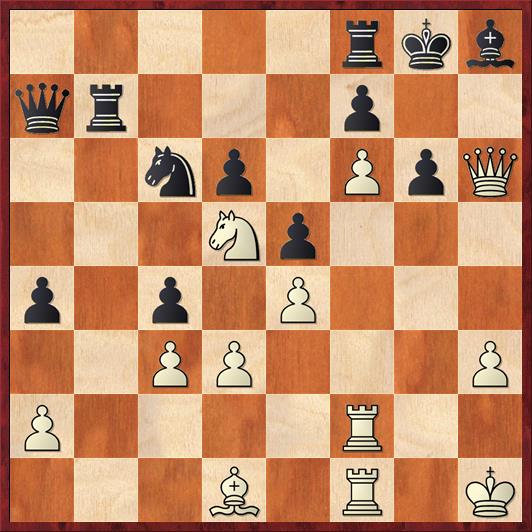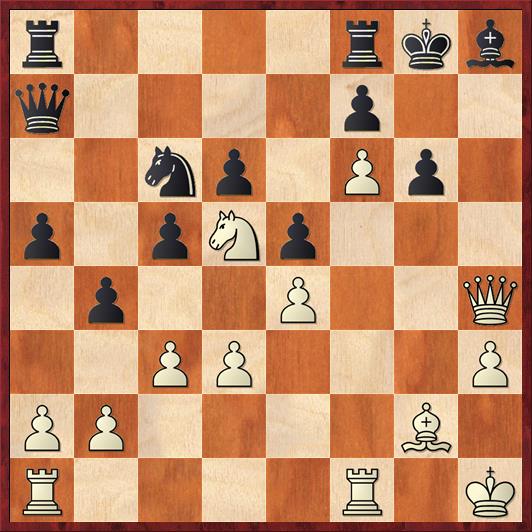In the most recent meeting of the Aptos Library chess club for kids, I decided to show them a position from a game that I played against Shredder, the computer. (Usually my lessons are taken from the excellent book Tactics Time by Tim Brennan and Anthea Carson, but every now and then I throw in positions from my own games or from recent master tournaments.)
 Position after 30. … c4. White to move.
Position after 30. … c4. White to move.
FEN: 5rkb/qr3p2/2np1PpQ/3Np3/p1p1P3/2PP3P/P4R2/3B1R1K w – – 0 31
As usual, I began by asking who is ahead in material (it’s even), what the opponent’s threats are (primarily 31. … cd) and whether we have any checks or captures (we could play 31. dc). These are questions I tell my students to ask in every position. But of course, sometimes these questions fail to get at the essence of the position, and that is certainly the case here. The most important thing to notice is that Black’s king is stalemated. We have talked about this before, as recently as last week. The reason it’s important is that when the opponent’s king has no moves, any check has a good chance of being a checkmate.
Unfortunately, the only check (leaving out the obviously bad queen sacrifices), 31. Ne7+, seems to come up short because of 31. … Nxe7 32. fe Rxe7. So this means we have to “manufacture” a check somehow with our other pieces.
I had gotten just this far when one of the students, a boy named Roman, raised his hand and said, “Why don’t you play 31. d4? That way you lure his pawn away from e5, and after 31. … ed you can play 32. Rf4!” (I’m paraphrasing because Roman and most of the other kids don’t really know chess notation yet. What he said was more like, “Why don’t you move the pawn on d forward?”)
I was surprised by his grasp of the concept of deflection (or “luring” to use his word), but I wanted to make sure he had the whole idea. So I asked, “Okay, what are you going to do next? What if Black plays, say, 32. … d3?”
Roman didn’t miss a beat. He said immediately, “I would move my rook over to the h-file.” I moved 33. Rh4 for him. “And what is your threat?” I asked. Once more he answered correctly, “Next move I’ll take on h8, and it will be checkmate.” Some other kids chimed in that Qh7 would also be checkmate. We looked at Black’s possible defenses like … Bg7 and … Bxf6, and saw that they led to checkmate, too.
This was one of the most surprising moments I’ve had as a chess teacher. Here is a kid who is still at a level where he regularly leaves pieces en prise, but he correctly combines a deflection, a rook lift, a battery and an “in-your-face checkmate” in a four-move mating combination! I was so impressed.
We actually continued to talk about the position after Roman’s solution, because a lot of the kids wanted to manufacture a checkmate by playing 31. Rg2 followed by 32. Rxg6+. I showed them that this was not such a good idea because it opens up the seventh rank for Black to defend with 32. … fg 33. Qxg6+ Bg7. Actually, my comments were perhaps a bit hasty, because Rybka takes exactly this approach, albeit with a different piece. Rybka’s recommended variation for White is 31. Bh5 cd 32. Bxg6! fg 33. Qxg6+ Bg7 34. fg Rxf2 35. Qe8+ Kxg7 36. Rg1+, with mate in two more moves. But in spite of the fact that this is the computer’s recommendation, I think that it lacks the simplicity and human comprehensibility of the rook lift followed by the mate on the h-file. That is a pattern you can repeat over and over again, while the variation I just gave in red is more or less unique to this position.
Finally the kids asked me how I finished the game, and I showed them the end: 31. Rf5! It’s the rook lift idea again, but one rank higher. And if he takes my rook, then I have manufactured a check on the g-file. But there is still one subtlety. The computer played 31. … Rb1 and I followed with 32. Rh5. Shredder is forced to play 32. … gh to avoid immediate checkmate. And now 33. Rg1+?? would be a terrible blunder, because of 33. … Qxg1+! followed by 34. … Rxd1+, with a draw likely.
Instead, I finished off the combination with Roman’s move: 33. d4! A second purpose of this move is revealed: it blocks the Black queen’s diagonal to g1. Now the computer cannot stop Rg1+, only delay it, so in fact Black resigned here.
Even though 31. Rf5! won by force, I actually like Roman’s move 31. d4! better, provided it’s played for the right reasons. As we can see now, there are two ideas behind it. One is Roman’s idea of deflecting the e-pawn. The other reason is to block that a7-g1 diagonal. So on 31. d4!, if Black does not take the d-pawn but plays something else, say 31. … Rb1 instead, then White plays 32. Rf5 and we transpose to the line I actually played. But the reason I like Roman’s move better is that by playing 31. d4! White shows that he is already aware of Black’s … Qxg1+ defense. In the game I was not aware of it. It was only after I played 31. Rf5 and 32. Rh5 that I realized, “Oh s***, if I play 33. Rg1+ he can take it.” Fortunately the move 33. d4 was still there. But it would have been much more stylish to make that move before it was needed, instead of as a last-second kludge.
Judea Pearl, my co-author on The Book of Why, taught me a quote I had not heard before, from rabbi Chanina: “I have learned much from my teachers and even more from my colleagues, but from my students I have learned the most of all.” Every day we must be prepared to learn from our students — it’s the greatest joy of teaching!
P.S. I don’t want to make a big deal of it, but this game was actually the first time I have beaten Shredder when set to its maximum rating of 2600. For anyone wanting to play the game through, this is how it went:
Dana Mackenzie – Shredder (2600): 1. e4 c5 2. f4 Nc6 3. Nf3 a6 4. g3 d6 5. Bg2 Nf6 6. d3 g6 7. O-O Bg7 8. Kh1 Bg4?! (I do not like this move and Shredder’s next two. It gives me two extra tempi for attack and then castles straight into the attack.) 9. h3 Bxf3 10. Qxf3 O-O 11. c3 e5 12. f5 b5 13. Na3 Qe7 14. Nc2 a5 15. g4 h6 16. g5 hg 17. Bxg5 b4 18. Ne3 Qa7 19. Bxf6 … (According to Rybka, 19. Nd5 immediately is also very strong.) 19. … Bxf6 20. Nd5 Bg7 21. Qg4 Kh7 22. Qh4+ Kg8 (If 22. … Bh6 23. Nf6+ Kg7 24. Ng4 Bd2 25. f6+ Kg8 26. Rad1. Black’s bishop runs out of squares on the c1-h6 diagonal, and White’s queen will get to h6 and checkmate on g7.) 23. f6 Bh8 (diagram)
 Position after 23. … Bh8. White to move.
Position after 23. … Bh8. White to move.
FEN: r4rkb/q4p2/2np1Pp1/p1pNp3/1p2P2Q/2PP3P/PP4B1/R4R1K w – – 0 24
At this point I was absolutely sure that White was winning. Black’s king is caught in a mating net with no way out. But just a couple of days earlier, I had blown a “winning” position against Shredder at its maximum strength by sacrificing too soon. I thought it was going to be a brilliant win, but instead Shredder found tactical resources I had not expected and was able to get a draw. Because of that game, I was determined not to sacrifice material unless and until it was necessary.
So here, in fact, the sacrifice 24. Rf5! already works. However, I was not 100 percent sure, and because I saw no way for Shredder to get out of its bind, I decided to take my time and “invite all my pieces to the party”.
24. Bf3 bc 25. bc Rab8 26. Rf2 Rb7 27. Raf1 Qa6 28. Be2 Qa7 29. Bd1 … (Threatening 30. Ba4 followed by 31. Bxc6, which would win without sacrifices.) 29. … a4 30. Qh6 c4. Now we arrive at the first diagrammed position, and you’ve seen the rest.



{ 1 comment… read it below or add one }
Hey, I have read couple articles of your blog. I think it is very interesting to me. I am a beginner of chess. I thought generally people won’t let the king go to very front, but the two chessboards showed that the white king is kind of close to the black king. I learned chess in Asia, so the strategies that teachers teach may be different.
Another question is how people image the chessboard and know how to place chess for the next step. I have practiced several times, but I still have a bit troubles to think the steps in my mind. Based on your many-year experiences, what can I do to improve my skill or learn some new strategies?